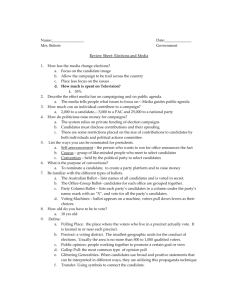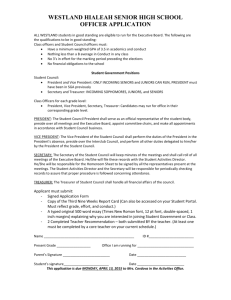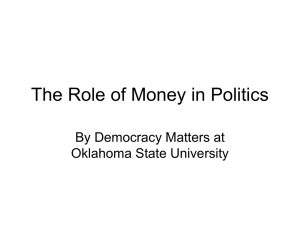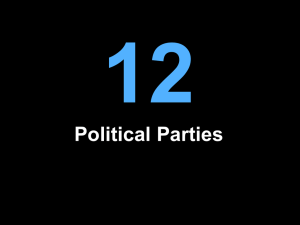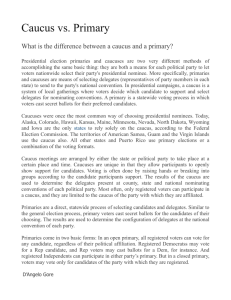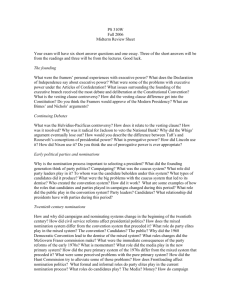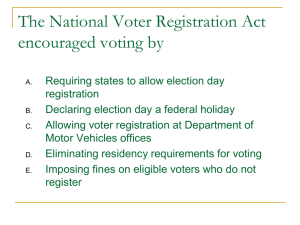Chapter 22: Political Parties on Our Democracy
advertisement
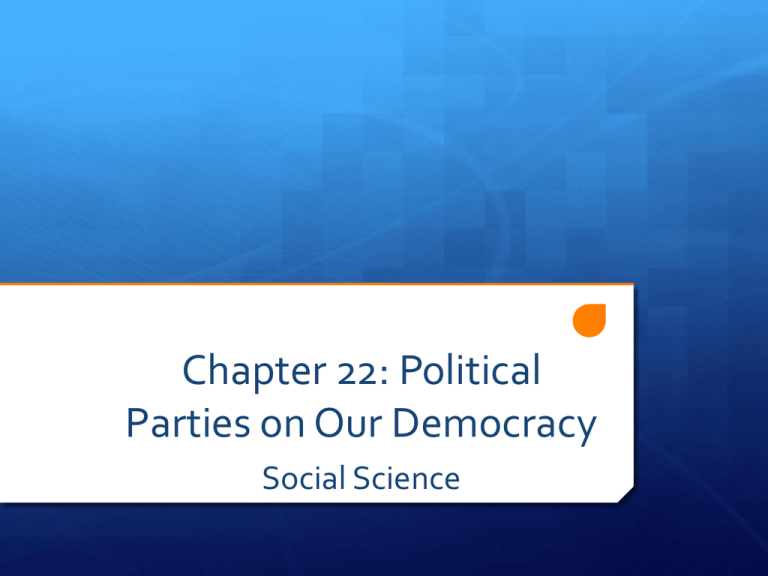
Chapter 22: Political Parties on Our Democracy Social Science Political Parties A political party is an organization of citizens who wish to influence and control government by getting their members elected to office Political parties nominate, or name, candidates to run for public office Some public offices, especially at the local level, are nonpartisan, meaning that the candidates do no declare themselves to be members of political party Each party has a platform, a statement of the party’s officials stand on major public issues, that are made up of planks, position statements on each specific issue in a party’s platform Planks turn into government programs based on the party’s ideals Parties provide leadership to citizens and to seats in government How Parties help Citizens Parties use persuasive tactics to make sure the public knows when a party in power is not doing its job Parties help provide a way for citizens to be heard Parties also provide citizens with information about news and programs that the party is organizing Arrange meetings and canvass, or go door-to- door handing out information and asking people which candidates they support Parties also provide ways in which citizens can get involved for their cause The Two Party System Political parties started during Washington’s presidency Sparked from disputes between Alexander Hamilton and Thomas Jefferson, they created the Federalist and Democratic-Republican party Our two party system developed in 1854, with the Republican Party developing from the Whig Party and the Democratic Party developing from the Democratic-Republican Party Even though political elections have been dominated by two parties, a third party may arise to support a cause or to back a candidate Can be difficult to form and run on a ballot, but if successful, can change the course of an election by taking votes away from other parties or by presenting new ideas Characteristics of Political Parties The Democratic Party supports taking responsibility for social programs, tax increases, and labor unions The Republican Party supports reducing the power of the federal government and that the state and local government should take responsibility for social programs Despite differences, political parties are similar because they generally have the same values and need to attract wide support from the public Organization of Political Parties Political parties are organized at the local level in the same way through precincts, or voting districts Each precinct has fewer than 1,000 voters, and each party has a chairperson or captain that organizes volunteers to try and get as many members as possible Precincts elect city and county committee leaders Political parties are organized at the state level through party committees, who organized state conventions and nominate candidates for office Each party holds a national convention every four years, where they nominate a candidate for President and Vice-President Changes in Party Strength Political parties have made their strengths in a combination of three elements: Patronage-a system in which party leaders perform favors for loyal supporters of the party Parties in Campaigns-nominees in campaigns can either depend in the party for support and funds or can create their own Voter Loyalty-voters can either vote on a straight ticket, or a ballot cast for all the candidates of one party, or a split ticket, or voting for candidates of more than one party on the same ballot One reason for declining loyalty is that some Americans choose their party membership and preferred candidates for different reasons Some voters are independent voters, or voters who do not support a particular party, so the key to gain their attention is through promotion Choosing Candidates The simplest way to become a candidate is through self-nomination, or declaring that you are running for office Can declare themselves a candidate and pay a filing fee, become a write- in candidate, or asks voters to write their name on the ballot, or can file a nomination petition Other ways of becoming a candidate is through nomination at a convention or through a caucus, or a meeting of party leaders to discuss issues or to choose candidates Most candidates for state or federal offices are chosen through a direct primary, or an election in which members of a political party choose candidates to run for office in the name of the party Use either a closed primary, or a primary in which a voter must be registered as a party member and may vote only in that party’s primary, or an open primary, or a primary in which voters do not need to declare a party before voting, but they may vote in only one party’s primary Choosing Presidential Candidates In presidential primaries, candidate raise money, mainly from individuals Each individual can only give $2,000 to each candidate per election Candidates can raise up to $31 million for their campaign Delegates are chosen in either a presidential preference primary election or a statewide caucus or convention In January and February of a presidential election year, the primary is held in New Hampshire and the caucus is held in Iowa In a presidential year, each party holds a national convention, where they discuss the candidates, vote on which candidate will run for President, and approve the party platform which the candidate will run on
